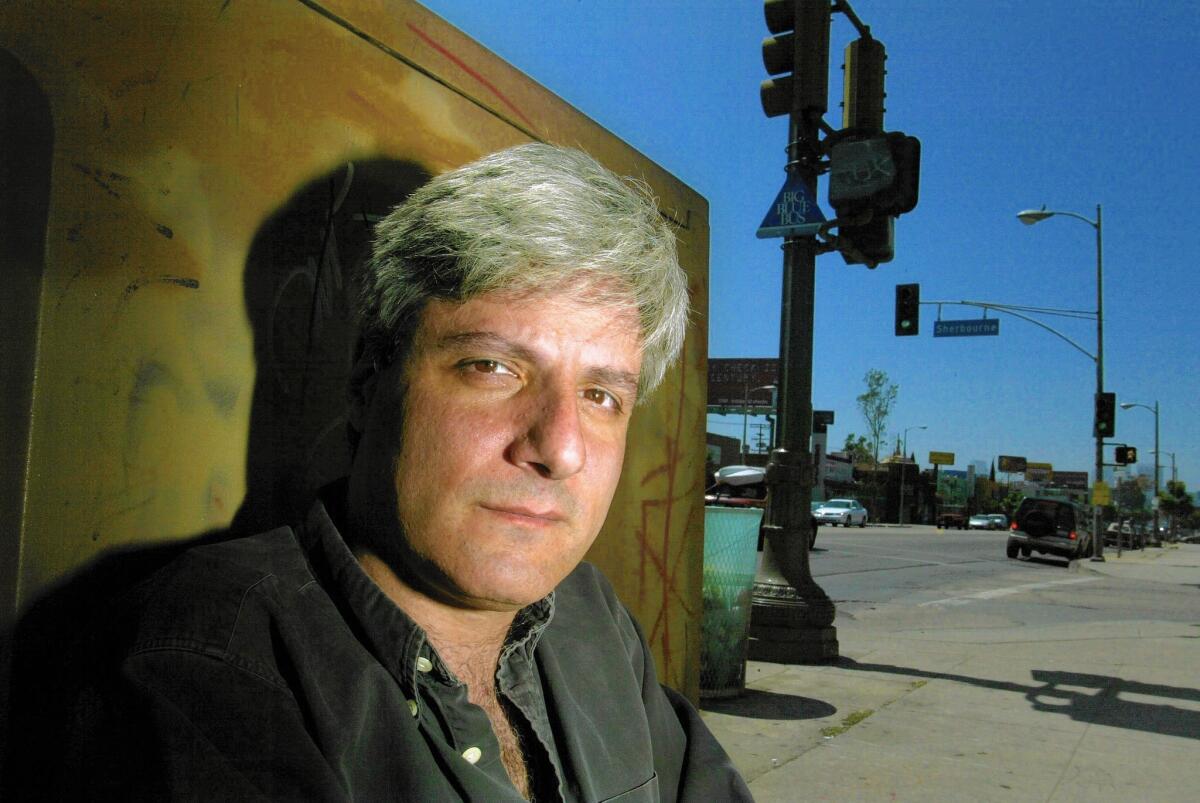Review: ‘Sidewalking’ author David Ulin jumps feet first into trying to understand Los Angeles

- Share via
“Sidewalking: Coming to Terms with Los Angeles” arrives at a particularly heady moment for rethinking the identity of the city. From the promise of new Metro lines and the possibility of the 2024 Olympics to architect Michael Maltzan’s provocative idea that the city has hit its outermost limit and must now splash back on itself, talking about L.A. seems far more popular than walking in it.
For Times book critic David Ulin, Los Angeles contains multitudes. Indeed, the peculiar magic of L.A., his book convincingly suggests, is that other cities, both real and imagined, are always coming into blurred focus on the edges of its existing streets and buildings. Whether this is because of a particular L.A. street standing in for Manhattan in every car commercial or if it’s because of the city’s infamous postmodernity — L.A.’s architecture mimicking, perhaps mocking, any style, anywhere — the result is the same. Los Angeles is a kind of urban zip file inside of which every other city has been compressed.
But all of this is just camouflage. Something like a real Los Angeles remains obscured, Ulin writes, literally invisible at the speed of an automobile. He thus sets out on foot to find this hidden city, hitting the pavement from the very first sentence for some ground-truthing, hoping to see firsthand what the metropolis has become.
Exploring L.A. on foot has, for Ulin, the feel of revelation — in some senses, quite literally, as the book begins with the unexpected sight of a church, stumbled upon during one of his walks. These discoveries — the church was always there, he had just never seen it before — illustrate one of the book’s central points: We do not need an entirely new metropolis, we simply need new ways to experience the one that is already here. If the real Los Angeles always seems both notoriously hard to access and deliberately concealed from public view, it could simply be because we don’t walk enough.
In essence, however, “Sidewalking” is a book about David Ulin, documenting his own journey from the built canyons of New York City to this metropolis of heat and sunlight, where even today, he points out, he remains “a reluctant Angeleno.” This autobiographical subtext gives the book its nuanced, even confessional tone, its first-person urbanism. L.A., seen through Ulin’s eyes, becomes a city-sized hall of mirrors in which the author attempts to lose, discover, refine and interrogate himself.
For a short book, “Sidewalking” is admirably wide-ranging in its chosen odysseys. Nonetheless, Ulin anchors the book in certain key locations, revealing his own sense of the city’s geography — and, alas, these can leave a little to be desired. Somewhat worryingly, for example, Ulin becomes preoccupied with the Grove, which dominates the second half of his book.
Ulin’s wry curiosity does not, at first, seem well served by such a site. He is so good at asking what constitutes a city that his own lack of travel to L.A.’s less well-documented corners becomes frustrating. Ulin would no doubt say that this misses his point — that the Grove is an experimental introduction of an entirely different kind of urbanism into the heart of commercial Los Angeles. Further, he might add, it represents a promising moment of urban otherness that, despite its clear financial motives and its popular, if not critical, appeal, remains somehow unseen in plain sight.
Yet the moments of true beauty in this shortest of books are precisely when Ulin reminds us that the everyday texture of Los Angeles — outside carefully staged destinations such as the Grove — already functions like a quantum field out of which distant influences, disorienting urban rebirths and half-remembered cinematic cameos are constantly emerging. It is a city of “seismic existentialism,” he wonderfully suggests, whose ground is shaken not just by earthquakes but by the seemingly endless eruption of alternative urban forms, often successfully breaking through.
Of course, the idea that a writer such as Ulin, with all of Los Angeles at his disposal, would take us to the Grove is in itself revealing — but of what? The penultimate chapter attempts to answer this with an ambitious widening of focus that shows, finally, what the implications of an outdoor mall’s success might be for the surrounding neighborhoods. Ending the book with a mix of registers, combining architectural criticism and natural history as he describes future changes awaiting nearby LACMA and Wilshire Boulevard, Ulin allows a cautious exuberance for his adopted city to shine through. Indeed, he waxes lyrically, watching subway stations and pedestrian boulevards take shape makes him “want to live forever, to experience Los Angeles as it will be in forty years, fifty, in a century, to engage with the urban landscape it becomes.”
It is amusingly perfect for Los Angeles, he implies, that something as mundane and secular as a J. Crew, serviced by an absurdist street trolley, might actually be a Trojan horse bringing with it a better and more walkable urban reality for us all. Indeed, Ulin’s Los Angeles is a city endlessly generous with gifts of transformation, revelation, and innovation — but it can be difficult to recognize them for what they are at first glance.
Manaugh is a freelance writer and the author of the forthcoming book “A Burglar’s Guide to the City.”
::
Sidewalking: Coming to Terms With Los Angeles
David Ulin
University of California Press: 152 pp., $16.95
More to Read
Sign up for our Book Club newsletter
Get the latest news, events and more from the Los Angeles Times Book Club, and help us get L.A. reading and talking.
You may occasionally receive promotional content from the Los Angeles Times.










